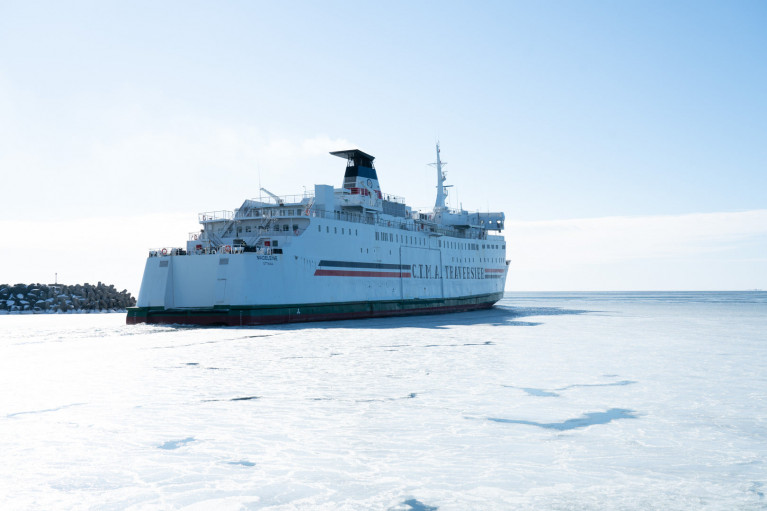B&I Line's 'last' Leinster, the fourth and final passenger ship to carry the famous Irish 'province' themed name, and the last ever Irish built cross-channel car ferry, has ended a career in Canada's east coast, writes Jehan Ashmore.
For almost the past 24 years, the former Leinster, renamed Madeleine had served Coopérative de Transport Maritime et Aérien (C.T.M.A) but branded as C.T.M.A. Traverseire, operating between Souris, Prince Edward Island and Cap-aux-Meules-Souris of the Magdalen Islands.
Madeleine had ran on the Canadian icy-waters of this French speaking region of the Îles-de-la-Madeleine, where shipping pass to enter the St. Lawrence River to reach Montreal.
On the 17th March, an appropriate date given the Irish connection!, as Madeleine made a final departure from the island. According to CTMA, Transport Canada is calling for tenders to dismantle the veteran vessel of four decades.
Afloat today tracked the Madeleine berthed at the port of Souri.
CTMA have acquired a replacement ferry from Spanish operator, Naviera Armas, Villa de Tero, which had been in the Canary Islands from where the Madeleine crew were dispatched to make the delivery voyage across the Altantic.
The newcomer is that of the abandoned newbuild hull for Viking Line, of their Viking ADCC, though the renamed Madeleine II, is now in its new home-waters though has yet to enter service.
The historic B+I Line established in 1836 and which the Irish Government acquired in 1965, was in a bad state in 1992 when sold into private ownership to Irish Continental Group (ICG), parent company of Irish Ferries.
The takeover of the fleet consisted of the company's owned Leinster along with the Wicklow, a lo-lo containership. In addition, there was the chartered Irish flagged Munster (introduced in 1990) and a B+I crew on the P&O ro-ro freight ferry Bison.
Following the Connacht (6,812grt) built in 1978 by Verolme Cork Dockyard (V.C.D.), B+I Line returned to the shipyard in Rushbrooke near Cobh, for a sister, the Leinster (6,808grt) which entered service in 1981 for the Dublin-Liverpool route.
Connacht as the leadship of the pair designed by Patrick Martin of VCD, a year later first launched onto the Cork-Swansea route (as referred in Brittany Ferries story).
What makes Leinster signifiant in Irish maritime shipbuilding history, is that the 1,500 passenger/326 car capacity ferry was the last ordered by B+I Line. Also the ferry would mark another maritime milestone as the finel cross-channel ro-ro ferry launched in an Irish shipyard.
Asides operating the Dublin-Liverpool link, Leinster and Connacht were designed to enter Liverpool Docks through the Waterloo Lock, which meant a beam of only 18.50m.
The Liffey-Merseyside route however closed in 1988 in favour of B+I serving just the short-sea routes of Dublin-Holyhead and Rosslare-Pembroke Dock.
The move from the overnight longer route was to compete on a more level basis with rivals, Sealink British Ferries, predecessor to Stena Line.
The Leinster under Irish Ferries was renamed Isle of Inishmore, serving on both the short-sea routes of Dublin-Holyhead and Rosslare-Pembroke Dock.
The latter route is where the ferry was renamed briefly Isle of Inishturk, this was to enable to free up the name for ICG's second custom built cruiseferry, Isle of Inishmore, which in June is to transfer to Irish Ferries new service of Dover-Calais.
Taking its direct replacement is the chartered Blue Star 1, and is currently in the Mediterranean bound for the Wexford port with an arrival next Monday.
While another former Irish Ferries ship, the French routes serving Saint Patrick II, also served as ferry for the same Canada operator as their C.T.M.A. Vancancier.
In recent years, the former Viking Line Aurella dating to 1973, was transferred to run cruises on the St. Lawrence River based out of Montreal to the Magdalen Islands, under a cruise division, Croisieres CTMA.
This season is cancelled due to Covid19, however they wish to return to cruises in 2022.






























































